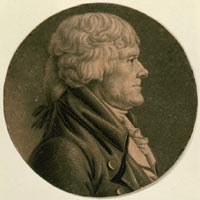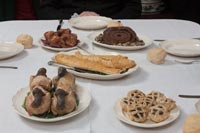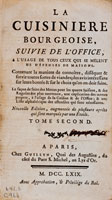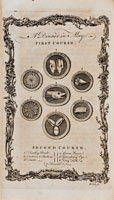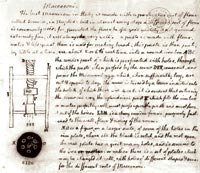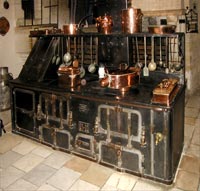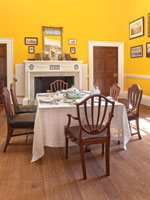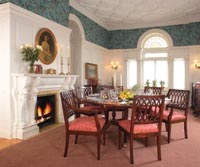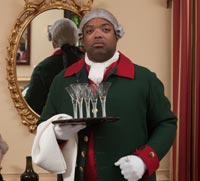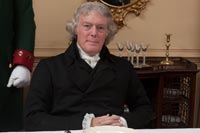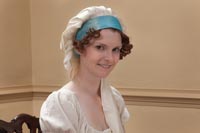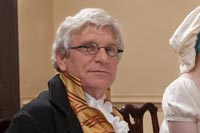Online Extras
Extra Images
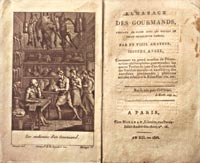
Wikimedia
The Almanach des gourmands, considered the first seasonal food journal, began publication in Paris in 1803.
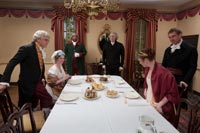
Dave Doody
Jefferson and dinner guests, interpreters Dale Trowbridge, Annalise Weindel, Stephen Seals, Stacy Hasselbacher, and Joseph Ziarko.
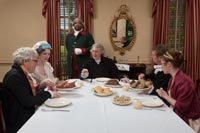
Dave Doody
Jefferson, portrayed by Bill Barker, brought French cuisine to the White House and to Monticello after his years as ambassador in Paris.
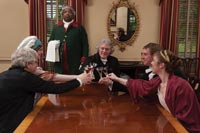
Dave Doody
Multiple courses of food, each with its own wine, were part of the French style of dining that Jefferson introduced to America.
Thomas Jefferson: Culinary Revolutionary
by Ed Crews
Thomas Jefferson arrived in Paris during 1784 in the middle of a French revolution—a culinary revolution. A no-holds-barred Gallic food fight was in full swing, and a centuries-old ancien régime in the kitchen was being chopped, diced, sliced, puréed, and flambéed into oblivion. With whisks, cleavers, and radical ideas about nutrition and style, avant-garde chefs were creating for the aristocracy nouvelle cuisine, the great-grandfather of today’s fine dining.
Then, as now, the French took cooking and wine seriously. Changes set off debates involving chefs, vintners, aristocrats, physicians, writers, religious leaders, and philosophers—notably Jean-Jacques Rousseau. Turmoil led to innovation, new dishes, and condiments that still delight diners. Mayonnaise, for example, was created in 1765, and Grey Poupon mustard in 1777. French cook Jean-Joseph Clause patented pâté de foie gras in 1784. Champagne, a Jefferson favorite, became popular. And the French started eating potatoes and invented pommes frites, which became an American mainstay now known as French fries.
A patriot and a representative of the American government, Jefferson was catholic when it came to food, and rapidly was seduced by French fare. He was an adventurous eater attracted to novelty and experiment. He liked most of what he saw and tasted, and he saw and tasted a lot. For instance, the Virginian sipped wine in Burgundy, dined at Versailles, and enjoyed take-out at his Parisian home, the Hôtel de Langeac on the Champs Elysées. Every dish drew him deeper into the country’s gastronomic rebellion, transforming him from observer to activist.
Jefferson’s support for nouvelle cuisine—here and abroad—gives him special status in American history. Gourmet Magazine, for example, named him one of the nation’s twenty-five most influential food figures, citing his “abiding appreciation of French food,” and his promotion of gourmet dining and new crops. The editors ranked him among such notables as cookbook author Fannie Farmer, TV personality Julia Child, and McDonald’s fast food king Ray Kroc.
Food historian Thomas J. Craughwell identifies the author of the Declaration of Independence as the nation’s premier foodie. “Thomas Jefferson was our first gourmet. He thought about food more than anybody else in America during his life. His views and interests, in fact, were a good 200 years ahead of his time,” Craughwell said during an interview. He is the author of the recently published Thomas Jefferson’s Crème Brûlée: How a Founding Father and His Slave James Hemings Introduced French Cuisine to America.
Some may dispute Craughwell’s conclusions. Yet, given Jefferson’s tastes, his willingness to sample new dishes, and his fascination with kitchen gizmos, such as a pasta maker, it’s clear that he has much in common with twenty-first-century Americans who watch the Food Network, worship celebrity chefs, and want meals made with local ingredients, precision, and a certain brio. Today’s gourmets rightly can see the eighteenth-century Virginian as a kindred spirit.
French food was very different from the plantation fare Jefferson ate before going to Paris. “Much American eighteenth-century food was ‘mushy.’ Cooks didn’t lavish a lot of attention on the food. Dishes typically were stewed or boiled. Gumbos and stews were common. Americans didn’t eat a lot of vegetables, but they did eat a lot of white bread. They liked desserts, the sweeter the better. When it came to alcohol, port, madeira, ale, and hard cider were popular,” Craughwell said.
Virginians ate a lot of meat and fish—roasted, broiled, boiled, stewed, and fried. There were beef, veal, pork, chicken, duck, geese, deer, squirrel, bass, catfish, shad, and sturgeon. If they consumed few vegetables, they had many choices: beans, beets, corn, cucumbers, lettuce, pumpkins, onions, peas, and squash, to name a few. African influences mixed in such vegetables as okra, black-eyed peas, red peas, and eggplant.
Cooks often worked at an open hearth in a stand-alone kitchen building. Using wood heat required skill, experience, and care. Spills occurred frequently, and fire was a constant danger. Fry pans, pots, and cauldrons were made of iron. These were unwieldy, relatively fragile, and not very efficient at distributing heat.
Jefferson never entirely rejected plantation fare, despite its heaviness and monotony. In France, he had shipped to him pecans and Virginia hams, which he considered superior to European examples. In his Paris garden, he planted crops from home, including corn, sweet potatoes, watermelon, and cantaloupe.
Still, Jefferson’s diplomatic posting in Paris put him in France’s political and epicurean capital, exposing him to the nation’s government and gourmets.
In the 1780s, one million people called Paris home, and they ate a lot of food. Hundreds of thousands of animals were consumed weekly. Fruit, vegetables, milk, and cheese poured into the city’s farmers' markets from across the region and the nation. A variety of wine and baked goods were available in the shops. If an ingredient, dish, or drink couldn’t be found here, it probably didn’t exist.
As intriguing as the variety of foodstuffs was what chefs for the upper classes were doing with them. In the early 1700s, they started discarding food preparation practices from the Middle Ages that still held sway. Broadly speaking, medieval cooking aimed to give a dish one powerful taste. The goal was to blend sweet and sour to provide sharp contrasts in flavor and texture, which explains why period recipes relied heavily on sugar, honey, spices, garlic, herbs, and vinegar.
By the 1600s, French aristocrats were taking their lead on food from Louis XIV, the Sun King, who loved elaborate dishes. Six-course meals were standard, and the quantity was gargantuan. Rococo best describes this sort of dining.
Eighteenth-century nouvelle cuisine rejected the ancient dishes and the over-the-top style. It was, according to food historian Susan Pinkard, the “art of cooking food delicately.” This implied a respect for the natural flavors of food and a desire to reveal—not to disguise—them. Nouvelle cuisine aimed for subtle tastes and levels of flavor, and demanded precision.
Less baroque than earlier food techniques, nouvelle cuisine still required work and skilled practitioners. There was a need for lengthy apprenticeships and large kitchen staffs. The new school of cooking prized simple, elegant presentation of dishes combined with a certain magical quality. One much-admired dessert featured ice cream served inside a fresh pastry. The trick was to keep the pastry hot and the ice cream cold.
Nouvelle cuisine originated in the aristocracy’s kitchens, but its influence became widespread. It inspired the middle class to embrace cuisine bourgeoisie, which tried for similar effects but relied on inexpensive ingredients, smaller kitchen staffs, and simpler recipes and techniques.
Unlike Americans, French cooks, regardless of where they worked, tended to prepare dishes on stoves, which often were coal fired. Gallic chefs relied chiefly on copper pots and pans, which were light, almost indestructible, and conducted heat uniformly. They were superior to American ironware.
Jefferson sampled French food at the king’s palace, at dinner parties, in taverns, on farms, and, perhaps, at a new creation—the restaurant. The first one, the Champ d’Oiseau, was a relatively modest operation and opened in Paris during 1765. Seventeen years later, restaurateur and legendary egomaniac Antoine de Beauvilliers launched the western world’s first luxury dining spot—La Grand Taverne de Londres—at 26 Rue de Richelieu. It was an instant hit with its superb cooking, elegant decor, superior service, and outstanding wine cellar.
Often, like modern Americans, the Virginian opted for take-out, especially during his first year in France. This came from taverns and caterers, called traîteurs. Regardless of where the meals originated, the food must have been good because invitations to dine with Jefferson were coveted. He set a standard for first-class hospitality in a city where entertaining has long been considered a fine art.
Jefferson’s Paris dinner companions included some of the brightest and most engaging people in Europe. Among his guests were aristocrats, like the marquis de Lafayette; political thinkers, like the marquis de Condorcet; American expatriates, like Gouverneur Morris; and artists, like Maria Cosway, the romantic infatuation of Jefferson’s widower life. We do not know exactly what Jefferson served in Paris. We do know his cook mastered at least crème brûlée, French fries, and macaroni and cheese. So these possibly appeared on the menu.
Jefferson was not content just to eat French food but insisted on learning all he could about its cultivation. In 1787, he toured southern France and northern Italy. Little missed his notice. His notes are filled with descriptions and sketches of farming implements, including plows and apple presses, and agriculture techniques for such crops as grapes, olives, almonds, pistachios, walnuts, figs, pomegranates, and strawberries.
Jefferson left Paris in 1789, but ensured he could enjoy French cuisine in the United States. His slave, James Hemings, had served apprenticeships and had mastered techniques and dishes. Plus, Jefferson shipped home 680 bottles of wine as well as olive oil, mustard, cheese, anchovies, a pasta maker, and copper pots and pans. Upon returning to Monticello, he installed stoves in the kitchen, providing cooks with the modern technology he saw in Europe.
Moving to the White House in 1801, he entertained with Parisian style. Meals provided an intimate way to meet leaders, to lobby, and to solve policy problems. Guest lists often were crafted with an eye to ensuring bipartisan harmony, and invitations were eagerly sought.
In Washington, the president ate breakfast and dinner. Most Americans also had a third meal. Dinner typically started about 3:30 p.m. and could go well into the evening. Jefferson typically hosted three dinners every week, and the guest list rarely exceeded twelve on each occasion. Meals were served à la française, which meant servants brought in the food but left the room while guests served themselves. Often, diners were awed by the quality and quantity. “Never before had such dinners been given in the President’s House nor such a variety of the fi nest and most costly wines,” wrote one gastronome. Another described his meal as “a very good dinner, with a profusion of fruits and sweet meats. The wine was the best I ever drank, particularly the champagne, which was indeed delicious.”
The menu for a meal easily could feature thirty-six dishes. One account of a typical spread mentioned rice soup, beef, turkey, mutton, ham, veal, fried eggs, ice cream, and fruit. We know that among the things the White House kitchen prepared were venison, bear, beef, ducks, partridges, oysters, shad, sturgeon, cabbage, spinach, potatoes, turnips, carrots, beans, pickles, pineapples, oranges, strawberries, watermelon, filberts, pecans, and cheese.
As a good host, Jefferson saw that French and American dishes sat side-by-side so any guest’s palate could be accommodated. Yet his cooks apparently never attempted a “fusion” of French and American cooking.
When he returned to Monticello, Jefferson entertained much as he had in Washington. The spreads at his mountain home were lavish, which attracted guests and, ultimately, strained his household budget. Given the glowing reports of Jefferson’s meals, one might assume that his enchantment with French food proved infectious in his native land.
It didn’t.
Instead, the United States was seeking its own culinary identity. People rejected traditional dishes based on English tastes. They were reluctant to try French fare, which struck many in the Federalist era as fussy, effete, and un-American.
Amelia Simmons, a critic of Gallic cuisine, wrote American Cookery, printed in 1796. Her disdain for French food is encapsulated by her note on garlic: “Garlicks tho’ used by the French, are better adopted to the use of medicine than cookery.”
As for nouvelle cuisine’s attempt to reveal food’s natural taste? It didn’t stand a chance on this side of the Atlantic. Why waste time with subtle flavors, went the thinking, when plenty of grease was handy. A French count wrote in 1804 that the United States was awash in it. “Their sauces,” he said, “even for roast beef, are melted butter; their turnips and potatoes swim in hog’s lard, butter or fat.”
Food, according to the prevailing American wisdom, should embody good republican characteristics— simplicity, honesty, robustness, and absence of pretense. Citizens should use native ingredients, avoid complex dishes, and give those they served such appropriately American names as Independence Cake, Federal Cake, and Congressional Bean Soup.
Jefferson’s promotion of nouvelle cuisine simply failed in the face of gastronomic chauvinism. That doesn’t mean he was a failure as its advocate. It simply means, as Craughwell said, that the Sage of Monticello was with food, as in other fields, a man of vision who was ahead of his time and his peers.
Ed Crews, a regular Colonial Williamsburg contributor, is an adventurous eater, a mediocre cook, and an avid grill master. He shares with our third president a weakness for macaroni and cheese, and French fries.

